#Global LNG Terminal Infrastructure
Explore tagged Tumblr posts
Text
The Global LNG Terminal Infrastructure: Key Players and Strategic Developments
Explore the dynamic landscape of Global LNG Terminal Infrastructure, highlighting the critical role of LNG Infrastructure in meeting global energy demands. Discover the significance of LNG Terminals in facilitating the storage and regasification of LNG, and learn about leading LNG Companies driving innovation and growth in the sector. This overview provides valuable insights into the strategic developments shaping the future of LNG and its infrastructure globally.
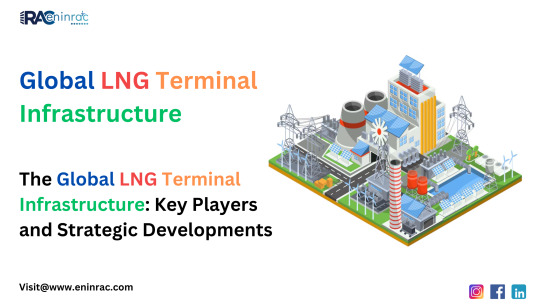
0 notes
Text
The Baltic states of Lithuania, Latvia, and Estonia are about to take a historic energy security step on February 9, when they will synchronize their former Soviet electricity systems with the Continental Europe Network (CEN). This will conclude the final chapter of Russia’s involvement in the energy sectors of these frontline European Union (EU) and NATO member states. But the Baltic states and their NATO allies must now work to secure this hard-won energy independence from Russia’s ongoing hybrid attacks on critical energy infrastructure.
Lithuania, Latvia, and Estonia have faced a wide array of Russian coercive energy policy measures arising from their historical dependence on Russian energy supplies and Soviet-era energy infrastructure. These measures included a total economic and energy blockade of Lithuania in 1990 in response to its independence movement, a prompt shutdown of an oil pipeline after Lithuania declined to sell its crude oil refinery to a Russian company in 2006, and long-term politically motivated gas pricing for the Baltics, to name just a few well-known cases.
Having faced the destructive impacts of Russia’s weaponization of energy, the Baltic states have become leaders among European nations in severing ties with Russia’s energy supplies over the past decade. The installation of the liquefied natural gas (LNG) terminal in Klaipėda, Lithuania’s seaport, in late 2014 marked a significant step in this direction. It opened the Baltic gas markets to global LNG suppliers, including those from the United States. This alternative gas supply route enabled the Baltic states to ban all Russian gas imports, both piped and LNG, just two months into Russia’s full-scale war against Ukraine. The Baltic states became the first European countries to take such a principled stance, and they are among those advocating for the rest of the EU members to follow suit by implementing a blanket ban on Russian LNG.
Flipping the switch
The timely diversification of oil and electricity supply routes also allowed the Baltics to stop importing these energy sources from Russia. In terms of electricity, the Baltic states use the interconnectors Estlink 1 and Estlink 2 between Estonia and Finland, Nordbalt between Lithuania and Sweden, and LitPol Link between Lithuania and Poland for power exchanges with Europe. However, the Baltic states’ early market-level integration with their EU neighbors did not mean the immediate end of Russia’s involvement in the their electricity sectors on the system control level.
These are the last days that the Baltic states’ power grids remain a part of the Russian-controlled Integrated Power System/United Power System (IPS/UPS) grid. This effectively means that a dispatch in Moscow is still responsible for maintaining electric frequency stability in the Baltic states—bringing all the risks that such a dependency on Moscow entails. Ukraine and Moldova performed a test desynchronization from the IPS/UPS grid concurrently with the onset of Russia’s invasion of Ukraine in 2022, immediately asking for an emergency synchronization with the European grid, which was granted. Lithuania was aware of the potential need to perform an emergency synchronization, too, and thus had prepared its power grid to function in an isolated mode if needed. On February 8, Lithuania, Latvia, and Estonia will decouple from the Russian-controlled grid and conduct a joint isolated operation test before joining the European grid on February 9.
The planning for the Baltic synchronization with the European grid began as early as 2007, but—due to multiple project phases involving political, regulatory, and infrastructural components in Lithuania, Latvia, Estonia, and Poland—it has only now been finalized. The project was co-financed by the EU, which has allocated more than €1.2 billion from its Connecting Europe Facility. For the EU, the project is as important as it is for the Baltic states: only with Lithuania, Latvia, and Estonia connected to the European grid can the EU achieve its goal of a fully integrated European energy market, in which all uncontrolled third-party impacts on its member states are eliminated.
Securing critical infrastructure
Although Russia will no longer exert direct influence over the energy supply and system control of the Baltic states, Moscow may now focus on targeting their critical energy, communications, and data infrastructure. Since October 2023, at least eleven cables running under the Baltic Sea have been damaged. This includes the underwater Balticconnector gas pipeline between Estonia and Finland; communications cables linking Finland, Germany, Sweden, and Lithuania; and the Estlink 2 power cable between Estonia and Finland. A data cable between Latvia and Sweden has been damaged as recently as January 26. The Lithuanian government is responding with increased military involvement in protecting critical seaborne energy infrastructure under the Baltic Sea amid an attempted sabotage of the NordBalt power cable that connects it to Sweden.
The damage was caused by vessels dragging their anchors on the Baltic Sea’s seabed. Investigations into the circumstances of the damage are still ongoing, but the rapid increase in such incidents and the vessels involved—mostly Russia’s “shadow fleet” oil tankers—raise concerns that the damage was intentional. As a response, NATO has stepped up its presence in the Baltic Sea by launching a new military patrol mission called Baltic Sentry. This mission involves deploying frigates, maritime patrol aircraft, and naval drones to enhance the ability of littoral states to respond to destabilizing acts on their critical infrastructure. The Alliance has also established a Critical Undersea Infrastructure Network to enhance information-sharing and situational awareness and a dedicated Maritime Centre for the Security of Critical Undersea Infrastructure within NATO’s Maritime Command in Northwood, United Kingdom.
Crucial first steps have also been made to increase the protection level of the onshore LitPol Link interconnector between Lithuania and Poland, through which the Baltics are synchronizing with the European grid. Lithuania’s Public Security Service has taken over the protection of several LitPol Link sites from a private security company that had previously been assigned this role. The Baltic states and Poland, fully aware of Russia’s hybrid activities in the region, have also urged the EU to provide financial support for enhancing current security measures for the LitPol Link and other critical energy infrastructure in the region.
It’s a start, but more needs to be done, particularly in the case of Lithuania. With vital interconnectors—LitPol Link in energy and Rail Baltica in transport and military logistics—passing through the country, Lithuania is emerging as a crucial gateway connecting continental Europe to the Baltics, the Nordic region, and even the Arctic.
All these interconnections traverse the narrow land corridor between Lithuania and Poland, known as the Suwałki Gap. This notorious area borders Belarus to the east and Russia’s Kaliningrad exclave to the west.
Russia could attempt to isolate the Baltics from the rest of Europe by obstructing the Suwałki Gap from these territories. Thus, beyond the punctual tactics of strengthening the security of the LitPol Link and, later, the planned additional onshore electricity interconnector between Lithuania and Poland that is reportedly set to run along the Rail Baltica tracks, an approach of a comprehensive protection regime for this vulnerable border area is needed. An increased NATO military presence in Lithuania and regional measures, such as installing the Baltic Defense Line along the Baltic states’ borders with mainland Russia, its Kaliningrad region, and Belarus, are important steps toward a solution.
With the Baltic power systems soon operating in harmony with those in continental Europe, the regional security agenda shifts from concerns over the security of energy supply to the protection of critical energy infrastructure. The Baltic nations and their allies should further enhance their proactive efforts to deter sabotage and secure this strategically vital region.
15 notes
·
View notes
Text
Critics point out that the production of LNG, when drilling, production and burning are considered, is a major driver of the climate crisis. Studies have shown that while gas emits less carbon dioxide than coal, it often also involves the leaking of large quantities of methane, a potent greenhouse gas.
“This is a carbon mega bomb,” said Jeremy Symons, a former Environmental Protection Agency official, of CP2, which has requested a permit to operate until 2050, a point when Biden aims for the US to have zeroed out its emissions. “The scale of the project is almost unfathomable and it locks us into a fossil fuel dependency for the next 30 years. If all we do is shift from coal to gas, we are cooked.”
According to calculations by Symons, who runs his own consultancy, the CP2 project would cause 197m tons of planet-heating gases each year once fully operational, including emissions from the production of the gas and its eventual burning overseas, which isn’t counted in the US’s own emissions tally.
This scale of emissions is 20 times greater than the controversial Willow oil project in Alaska, which was approved by the Biden administration despite a huge outcry from Democrats, tribes and climate campaigners earlier this year.
Should several dozen other proposed gas-export facilities along the Gulf of Mexico also be built, then the overall emissions toll would be gargantuan, according to figures Symons shared with the Guardian. If all planned terminals go ahead, it would result in an extra 3.2bn tons of greenhouse gases each year, he found, close to the annual emissions of the entire European Union and severely imperiling hopes of avoiding catastrophic global heating.
“It’s an unbelievable amount of pollution and it would spell game over for a livable planet as we’ve known it,” said Symons. “We would double LNG production just with the gas terminals that have been proposed, meaning we are just shifting emissions overseas even as we act on climate here in the US. We’ve left the back door wide open, and profit-seeking oil-gas companies are taking full advantage.”
The CP2 project is awaiting permission from the Federal Energy Regulatory Commission (Ferc), which regulates pipelines, as well as the US Department of Energy. Several Democratic lawmakers have criticized Ferc, and the Biden administration, for repeatedly approving huge gas projects despite concerns over damage to the climate as well as to the air and water of nearby communities, already overburdened by a tangle of oil and gas infrastructure along the Gulf coast.
Ferc has been “captured by the fossil fuel industry”, complained the US senator Jeff Merkley, an Oregon Democrat, after the agency approved a separate gas plant in the Pacific north-west last week. “Ferc may be an obscure federal agency to most people, but there are important decisions on the horizon at Ferc that will determine whether the world meets its climate goals,” he said. “With projects such as the Calcasieu Pass 2 LNG export terminal on the horizon, right now, the signs aren’t good.”
5 notes
·
View notes
Text
XR Boston plays basketball in halls of MA State House to demand Governor ban new fossil fuel infrastructure
On Monday September 18, more than 30 climate activists from Extinction Rebellion Boston (XR) played a creative version of basketball in the halls of the Massachusetts State House, to demand that Governor Maura Healey "stop playing games with our future." The activists split into two "teams," one team representing the government (with sponsorship logos for fossil fuel companies on their jerseys) and the other team representing "New Fossil Fuels". On the second floor outside Governor Healey's office, activists made raucous throwing and dribbling motions, while shouting as if in game-play. Meanwhile, other activists playing the role of Massachusetts residents as spectators carried banners and shouted for the game to end. Spectator chants included: "Commonwealth, you’re breaking the rules, don’t pass the ball to Fossil Fuels! You’re our home team, we must win! It’s our planet, go all-in! Fossil fuels, aren’t you ashamed? It’s our future, not a game! We see your fouls to make a basket, there’s no games on a dead planet!" These activists managed to disrupt business as usual for a full afternoon. After a long game, the crowd of activists occupied the Governor's Constituents office for two hours until eight arrests were made. During the occupation, they chanted together and sang protest songs in high spirits. As arrestees were led away, their cohorts sang "Courage [activist's name], you do not walk alone, we will walk with you, and sing your spirit home."
These activists managed to disrupt business as usual for a full afternoon. After a long game, the crowd of activists occupied the Governor's Constituents office for two hours until nine arrests were made. During the occupation, they chanted together and sang protest songs in high spirits. As arrestees were led away, their cohorts sang "Courage my friend, you do not walk alone, we will walk with you, and sing your spirit home."
Extinction Rebellion Boston's demand is No New Fossil Fuel Infrastructure in Massachusetts.
Banning new fossil fuel infrastructure includes:
NO new fossil fuel power plants
NO new residential or commercial gas connections
NO new or expanded natural gas distribution pipelines, transmission pipelines, or compressor stations
NO new liquified natural gas production facilities, storage facilities, or terminals
NO new gas stations or other gasoline and diesel infrastructure
NO new airports or airfield expansions
Stopping new fossil fuel infrastructure under development includes:
MMWEC’s Peaker Plant in Peabody
NEC’s Liquified Natural Gas Facility in Charlton
LNG expansion to Douglas
L.G. Hanscom Airfield's North Airfield Development in Bedford
"Modernization" projects in Lowell and Worcester
"Reliability" projects in Western Mass. and Sharon-to-Brockton
The Hopkinton-Ashland Transfer Line
Meter stations in Longmeadow and Charlton
Why are we using creative disruption? Asking nicely hasn't kept humanity safe from the effects of climate change, neither has writing letters and petitions, neither has hopes and prayers. The global average temperature for July 2023 is confirmed to be the highest on record for any month, and August 2023 was the hottest August in recorded history. We gasp through wildfire smoke, and our neighbors to the north wade through floodwaters. What more will it take before our government takes action?
Full article here: https://xrboston.org/news/xr-boston-plays-basketball-in-halls-of-ma-state-house-to-demand-healey-administration-ban-new-fossil-fuel-infrastructure/








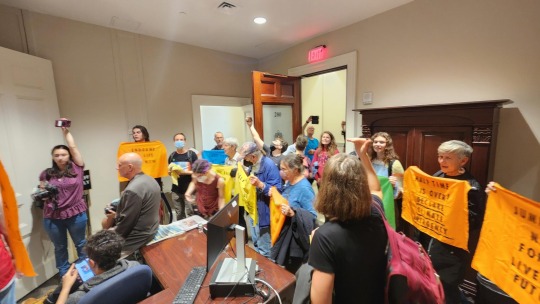
#extinction rebellion#climate activism#civil disobedience#state house#massachusetts#Maura Healey#basketball#chanting#fossil fuels
3 notes
·
View notes
Text
From Sea to Shell Shock: $CGBS vs Shell
Shell’s reality check just got real. In 2024/25, the “climate-friendly” oil giant is feeling the squeeze: it lost a climate case in South Africa (Wild Coast drilling blocked) and quietly axed hundreds of oil-and-gas jobs. The new CEO is canceling big green projects – offshore wind plans are on hold to save costs. Meanwhile, Crown LNG ($CGBS) is steering clear of courtroom dramas. It’s quietly signing engineering contracts and pushing pipeline plans – actual construction, not court filings.
Conflict vs. Construction: Shell’s headlines are full of lawsuits and layoffs; Crown’s are full of contracts and concrete. Shell cut jobs and defended climate suits; Crown picked port sites and fired up survey vessels. One’s PR fatigue; the other’s progress.
Legacy vs. Launch: Shell has massive LNG infrastructure in place (Europe’s biggest terminals, global stake) – stable but hardly growing. Crown’s building new stuff one project at a time – more like LEGO blocks than a monolith. Shell’s a cruise liner; Crown’s a speedboat catching waves.
Vision vs. Reality: Shell talks net-zero by 2050, but keeps drilling and quietly canceled many green projects. Crown isn’t pretending to be carbon-free, but it’s built for the transition – moving cleaner gas instead of coal. It’s building energy infrastructure, not just new PR slogans.
Dividends vs. Dreams: Shell’s loyalty comes with a juicy dividend (~5%). Crown’s paying nothing yet – plowing every dollar into growth. Want yield? Shell’s your queen. Want upside? Crown’s king (pun intended).
Investor Buzz: Shell is huge – no TikTok hype there. Crown’s tiny float means any new LNG deal could set it on fire. Shell’s ticker is billboard-level; Crown’s a whisper in energy forums – but whispers can become roars.
Shell has decades of headlines; Crown’s writing its first chapter. Are you rooting for the weathered giant or the hungry newcomer? 😎🌍
0 notes
Text
Sandstorms and Pipelines: $CGBS vs ADNOC
ADNOC, the Abu Dhabi oil powerhouse, might have a private jet and an OPEC+ seat, but is that future or the past? The UAE’s national champion is on a $150B mission to pump 5 million barrels a day by 2030 – building pipelines thicker than camel humps to shuttle crude around the world. Just recently, ADNOC inked a deal to boost its Upper Zakum output with Exxon, and even approved a $5B gas-expansion plan at home. Meanwhile, Crown LNG ($CGBS) is doing something different: building demand-side infrastructure. While ADNOC is exporting more oil, Crown’s stringing LNG terminals from Europe to Asia to meet that demand.
Scale vs. Specialisation: ADNOC is everything-big: mega oil fields, giant pipelines, and an oil-sovereign fund. Crown is niche-focused: just LNG terminals (like the planned FRSU in Scotland or a regas barge in India). One is a Swiss Army knife; the other is a laser pointer.
Global Politics vs. Local Projects: ADNOC plays international chess – balancing OPEC quotas, routing around the Strait of Hormuz, wooing foreign investors. Crown’s game is local: building where people need heating, with no quotas in play. It’s like saying “No thanks” to geopolitics, “Yes please” to customers.
Money Moves: ADNOC is flush: it drops billions on drilling rigs, pipelines and refineries without blinking. Crown’s capital is lean: every dollar goes to one project at a time. Big oil empire vs lean startup hustle.
Emulating Crown’s Thesis: The giants are copying Crown’s vision at scale. Shell predicts LNG demand +60% by 2040 (driven by Asia and even AI datacenters). Exxon is pouring cash into the Golden Pass LNG export hub. ADNOC itself just green-lit a multi-billion gas build-out domestically. They’re doubling down on global gas – basically the same train Crown boarded, but at bullet-train speed.
Culture Clash: ADNOC might throw a gala for a new refinery. Crown will put on a hard hat and hit the construction site. One’s classic big-oil scene; the other’s a scrappy global energy entrepreneur.
Bottom line: Bet on the desert oil monarch or the nimble LNG upstart? ADNOC’s all-in on oil horsepower; Crown’s flexing lean LNG muscle. Old-Economy or New-Era? The market’s already partly chosen now it’s your turn. 🔥🏜️
1 note
·
View note
Text
Green Hydrogen Market Accelerates as Governments and Industry Race Toward Net-Zero Goals
Market Square Insights Identifies Green Hydrogen as a Central Pillar of the Global Clean Energy Transition
The Green Hydrogen market is experiencing explosive growth, driven by the global urgency to decarbonize energy systems, reduce industrial emissions, and secure sustainable fuel alternatives. As highlighted in a new report by Market Square Insights, green hydrogen is becoming a cornerstone of clean energy infrastructure, with robust investment pipelines and policy support fueling industry momentum.
Market Overview
Green hydrogen is produced through electrolysis of water using renewable energy sources like solar, wind, or hydropower—unlike grey or blue hydrogen, which rely on fossil fuels. As a zero-emission energy carrier, green hydrogen holds immense promise across sectors including power generation, heavy industry, mobility, and aviation.
For In depth Information Get Free Sample Copy of this Report@
Europe, Japan, and Australia have been early movers, launching national hydrogen strategies. Meanwhile, emerging economies such as India, Chile, and Saudi Arabia are investing in mega-scale electrolyzer projects and green hydrogen corridors.
Green Hydrogen Market key Players
Air Liquide
Siemens Energy
Plug Power Inc.
Nel ASA
ITM Power
Linde plc
Cummins Inc.
Engie SA
Ballard Power Systems
Bloom Energy
More Selling Reports: -
Industrial demand is surging from applications in:
Steel and cement manufacturing (as a carbon-neutral process heat source)
Green ammonia and methanol production
Fuel-cell-powered transport including trucks, buses, and trains
DROC Analysis: Drivers, Restraints, Opportunities, and Challenges
Drivers:
Global decarbonization commitments and government subsidies
Rapid cost decline in renewable electricity and electrolyzer technology
Corporate sustainability pledges from energy giants and chemical producers
Restraints:
High initial capital expenditure for production infrastructure
Limited hydrogen transport and storage infrastructure in key markets
Opportunities:
Development of international green hydrogen trade routes
Integration into existing LNG terminals and refining operations
Emerging applications in shipping and long-haul aviation
Challenges:
Scaling up from pilot to commercial-scale production at competitive cost
Policy inconsistencies and lack of unified certification standards
Need for skilled workforce and public-private partnerships
Market Trends and Forecast
Emerging trends include:
Surge in electrolyzer gigafactory announcements in EU, US, and India
Growth of green hydrogen hubs near renewable energy zones
Collaboration between oil majors, tech firms, and governments
Expansion of blended hydrogen-natural gas pipelines and microgrids
For In depth Information Get Free Sample Copy of this Report@
About Market Square Insights:
At Market Square Insights, we understand research requirements and help a client in taking informed business-critical decisions. The company focuses on helping the clients achieve transformational growth by helping them make crucial business decisions. At Market Square Insights, we diligently study emerging trends across various industries at global and regional levels, to identify potential opportunities for our client.
Contact us:
Market Square Insights,
56/3, Kawade Nagar,
Sai Mandir Road, Near HDFC Bank,
New Sangavi, Pune-61
IND: +91 9405802422
0 notes
Text
Indian oil and gas demand supply
India’s oil and gas demand-supply landscape is evolving rapidly, driven by economic growth, energy transition goals, and rising urbanisation. Indian Petroplus provides detailed coverage of this dynamic sector, offering critical insights into consumption trends, production capacity, and import dependency shaping the country’s energy strategy. India is the third-largest energy consumer globally, with oil demand projected to reach nearly 11 million barrels per day by 2045, according to the IEA and OPEC forecasts. Currently, the country consumes around 5 million barrels per day, with transport and industrial sectors being major contributors. Domestic crude oil production, however, meets less than 15% of demand, leading to heavy reliance on imports, primarily from the Middle East, Africa, and the US. Natural gas consumption is also growing steadily as India moves towards cleaner fuels. The government targets raising the share of gas in the energy mix from around 6% to 15% by 2030. However, domestic production has struggled to meet demand, prompting an increased focus on LNG imports, regasification terminals, and city gas distribution (CGD) networks. To address the supply gap, upstream investments are being ramped up. ONGC, Oil India Ltd, and private players like Reliance-BP and Vedanta are developing new fields and enhancing recovery from mature basins. Simultaneously, downstream infrastructure – including refineries, pipelines, and LNG terminals – is being expanded to ensure efficient delivery. Indian Petroplus provides comprehensive updates on crude and gas supply, consumption data, import-export trends, policy changes, and price movements. It also tracks strategic reserves, refinery throughput, and demand forecasts across sectors. With energy security becoming a national priority, bridging the demand-supply gap in oil and gas is crucial. Stay updated with Indian Petroplus for reliable analysis, project updates, and real-time trends impacting India’s oil and gas consumption and supply outlook, Indian Oil And Gas, India Energy Sector, India Energy Sector, Oil Gas Trends India, Oil Supply India, Indianpetroplus.
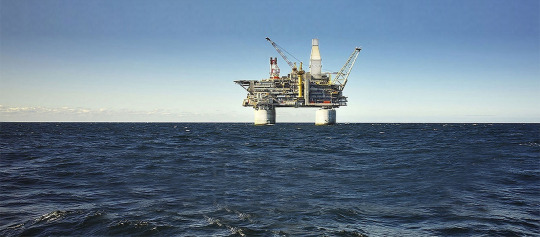
0 notes
Text
The Rising Logistics Hub of Southeast Asia
Nam Dinh Vu Industrial Park: The Rising Logistics Hub of Southeast Asia
As global supply chains evolve, businesses are seeking strategic locations that offer seamless connectivity, modern infrastructure, and cost-effective logistics solutions. Located in Hai Phong – Vietnam’s leading port city, Nam Dinh Vu Industrial Park is emerging as a key logistics hub in Southeast Asia. With its integrated port system, extensive warehousing facilities, and investor-friendly policies, Nam Dinh Vu is attracting international enterprises looking to optimize their supply chain operations.
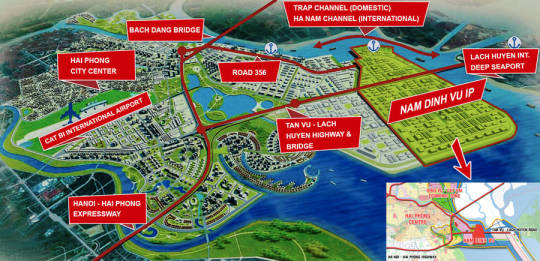
A Strategic Location at Vietnam’s Trade Gateway
Nam Dinh Vu IP benefits from its prime location in Hai Phong, one of Vietnam’s most dynamic economic centers. As the closest deep-water port system to major international shipping routes, Hai Phong serves as the main gateway for trade between Vietnam and global markets, including China, ASEAN, Europe, and North America.
Situated within the Dinh Vu IP – Cat Hai Economic Zone, Nam Dinh Vu IP enjoys preferential tax policies and direct access to a multimodal transport network, including:
Deep-water seaports: Immediate connectivity to international shipping lanes.
Expressways: Fast road access to Hanoi, Quang Ninh, and major industrial zones.
Rail links: Planned connections to national and regional railway systems.
This strategic positioning enables businesses to efficiently move goods while reducing transportation time and costs.
An Integrated Logistics Ecosystem
With a total area of 1,329 hectares, Nam Dinh Vu Industrial Park is comprehensively planned with a modern, multi-functional layout, divided into four main zones:
Port & Logistics Zone (Zone A: 82 ha): Nam Dinh Vu Container Port has been in operation since 2018.
Petroleum & Chemical Zone (Zone B: 30 ha): Includes a liquid cargo port and storage tanks for petroleum, gas, and chemicals.
Industrial Zone (Zone C: 106.7 ha): Dedicated industrial land with full utilities extending to each plot.
Complex Zone (Zone D: 960 ha): A multi-functional area for industrial activities and warehousing.
Why Global Investors Choose Nam Dinh Vu IP
As supply chain resilience becomes a priority, companies are increasingly turning to Vietnam as a key manufacturing and logistics destination. Nam Dinh Vu IP offers:
On-site customs services: Streamlined processes for faster clearance and reduced wait times.
Logistics solutions: Efficient transportation services with competitive pricing.
Energy supply: Reliable access to LNG and LPG, offering clean and sustainable energy options.
Investment support: Complimentary assistance with investment registration, business setup, and land use rights.
Workforce recruitment: Talent sourcing, job fairs, and employee training support.
Future Prospects & Expansion Plans
With rising global trade and Vietnam’s increasing role in international logistics, Nam Dinh Vu IP is set to expand further. The upcoming development phases include:
New deep-water terminals to increase cargo handling capacity.
Expansion of industrial land to accommodate high-tech and green industries.
Smart logistics solutions integrating digital transformation and automation.
The Success of Singapore Enterprises in Vietnam: A Promising Outlook for Nam Dinh Vu IP
Singapore has firmly established itself as a leading foreign investor in Vietnam, with approximately 3,800 projects and cumulative investments exceeding US$81 billion, ranking second among 145 countries and territories (1). Singaporean enterprises have significantly contributed to Vietnam’s economic growth, particularly in sectors such as manufacturing, real estate, and energy. Looking ahead, Singaporean investors are keen to expand their collaboration with Vietnam in emerging fields, including the digital economy, circular economy, renewable energy, sustainable industrial parks, and green finance (2). With its strategic location, integrated logistics ecosystem, and investor-friendly policies, Nam Dinh Vu Industrial Park presents a compelling opportunity for Singaporean businesses seeking to capitalize on Vietnam’s evolving industrial landscape.
In conclusion, as Southeast Asia continues to thrive as a global manufacturing hub, Nam Dinh Vu is well-positioned to lead the region’s logistics and supply chain transformation.
vietnam industrial zone map
Source
(1). Cong Thuong Newspaper
(2). Ha Noi Times Newspaper
0 notes
Text
Brazil LNG Market Size, Growth Opportunities & Trends Forecast
Brazil LNG Market Overview The Brazil Liquefied Natural Gas (LNG) market is witnessing robust development, with an estimated valuation of USD 1.8 billion in 2024. It is projected to grow at a compound annual growth rate (CAGR) of 7.2% over the next 5–10 years. This growth trajectory is fueled by increased demand for cleaner energy alternatives, expanding natural gas infrastructure, and Brazil's shift from hydro-dominant power generation towards a more diversified energy matrix. LNG has become essential for meeting energy needs in industrial applications, power generation, and transportation. Additionally, the Brazilian government’s support for privatization and liberalization in the gas sector further enhances LNG’s role as a pivotal energy source. Brazil LNG Market Dynamics Drivers: Key market drivers include increasing industrialization, rising demand for reliable and cleaner energy, and the expansion of gas-to-power projects across the country. The Gas Law reform, aimed at creating a competitive and open market, has also stimulated private investment in LNG infrastructure. Restraints: However, challenges such as high initial infrastructure costs, limited domestic liquefaction capacity, and logistical constraints in LNG transportation pose hurdles to seamless market expansion. Opportunities: Opportunities lie in offshore LNG regasification units, floating storage regasification units (FSRUs), and the integration of LNG into remote and off-grid areas. Furthermore, international collaboration for LNG imports opens up significant opportunities for energy security and supply diversification. Technology, Regulation & Sustainability: Technological advancements in LNG cryogenics, regasification, and storage are making operations more efficient and cost-effective. Regulatory support through ANP (National Agency of Petroleum, Natural Gas and Biofuels) frameworks is creating a more transparent and investor-friendly ecosystem. Sustainability goals, including Brazil’s 2050 net-zero target, are pushing LNG as a transitional fuel in the decarbonization roadmap. Download Full PDF Sample Copy of Brazil LNG Market Report @ https://www.verifiedmarketresearch.com/download-sample?rid=491586&utm_source=PR-News&utm_medium=380 Brazil LNG Market Trends and Innovations Emerging trends in the Brazil LNG market include the adoption of modular LNG terminals and the development of small-scale LNG solutions to reach underserved regions. Floating LNG terminals and FSRUs are rapidly gaining traction due to lower capital expenditure and faster deployment times. Technological innovations such as AI-driven demand forecasting and real-time monitoring systems are being increasingly adopted to enhance supply chain efficiency. Collaborative ventures between international energy giants and Brazilian firms are strengthening knowledge transfer and technology penetration. Companies are investing in digital transformation initiatives and exploring LNG as a marine and heavy-duty vehicle fuel, aligning with global low-carbon trends. Brazil LNG Market Challenges and Solutions Challenges: Major challenges include volatile LNG pricing linked to global benchmarks, limited pipeline connectivity in remote regions, and dependency on imports due to insufficient liquefaction infrastructure. Moreover, regulatory bottlenecks in environmental licensing can delay project execution. Solutions: Addressing these obstacles involves strategic investments in domestic liquefaction capabilities, expanding inter-regional pipeline infrastructure, and streamlining environmental approval processes. Government incentives, public-private partnerships (PPPs), and tax benefits can further mitigate capital risks and attract long-term investors. Brazil LNG Market Future Outlook The Brazil LNG market is poised for sustained expansion, driven by policy liberalization, growing private sector participation, and a strategic pivot towards natural gas in Brazil’s energy transition strategy. The market is expected
to surpass USD 3 billion by 2030, underpinned by rising urbanization, increasing LNG-fueled transport initiatives, and the decarbonization of industrial operations. Technological integration, enhanced import infrastructure, and strategic alliances will be central to unlocking market potential. As Brazil strengthens its position as a regional LNG hub, it will play a critical role in South America's clean energy evolution. Brazil LNG Market Competitive Landscape The Brazil LNG Market competitive landscape is characterized by intense rivalry among key players striving to gain market share through innovation, strategic partnerships, and expansion initiatives. Companies in this market vary from established global leaders to emerging regional firms, all competing on parameters such as product quality, pricing, technology, and customer service. Continuous investments in research and development, along with a focus on sustainability and digital transformation, are common strategies. Mergers and acquisitions further intensify the competition, allowing companies to broaden their portfolios and geographic presence. Market dynamics are influenced by evolving consumer preferences, regulatory frameworks, and technological advancements. Overall, the competitive environment fosters innovation and drives continuous improvement across the Brazil LNG Market ecosystem. Get Discount On The Purchase Of This Report @ https://www.verifiedmarketresearch.com/ask-for-discount?rid=491586&utm_source=PR-News&utm_medium=380 Brazil LNG Market Segmentation Analysis The Brazil LNG Market segmentation analysis categorizes the market based on key parameters such as product type, application, end-user, and region. This approach helps identify specific consumer needs, preferences, and purchasing behavior across different segments. By analyzing each segment, companies can tailor their strategies to target high-growth areas, optimize resource allocation, and improve customer engagement. Product-based segmentation highlights variations in offerings, while application and end-user segmentation reveal usage patterns across industries or demographics. Regional segmentation uncovers geographical trends and market potential in emerging and developed areas. This comprehensive analysis enables stakeholders to make informed decisions, enhance competitive positioning, and capture new opportunities. Ultimately, segmentation serves as a critical tool for driving focused marketing, innovation, and strategic growth within the Brazil LNG Market. Brazil LNG Market, By Type Brazil LNG Market, By Application Brazil LNG Market, By End User Brazil LNG Market, By Geography • North America• Europe• Asia Pacific• Latin America• Middle East and Africa For More Information or Query, Visit @ https://www.verifiedmarketresearch.com/product/brazil-lng-market/ About Us: Verified Market Research Verified Market Research is a leading Global Research and Consulting firm servicing over 5000+ global clients. We provide advanced analytical research solutions while offering information-enriched research studies. We also offer insights into strategic and growth analyses and data necessary to achieve corporate goals and critical revenue decisions. Our 250 Analysts and SMEs offer a high level of expertise in data collection and governance using industrial techniques to collect and analyze data on more than 25,000 high-impact and niche markets. Our analysts are trained to combine modern data collection techniques, superior research methodology, expertise, and years of collective experience to produce informative and accurate research. Contact us: Mr. Edwyne Fernandes US: +1 (650)-781-4080 US Toll-Free: +1 (800)-782-1768 Website: https://www.verifiedmarketresearch.com/ Top Trending Reports https://www.verifiedmarketresearch.com/ko/product/north-america-pumped-hydro-storage-market/ https://www.verifiedmarketresearch.com/ko/product/north-america-liquid-hydrogen-market/ https://www.verifiedmarketresearch.com/ko/product/japan-engineering-plastics-market/
https://www.verifiedmarketresearch.com/ko/product/france-led-lighting-market/ https://www.verifiedmarketresearch.com/ko/product/australia-architectural-coatings-market/
0 notes
Text
Global Small-Scale LNG Market Set to Grow at 14.5% CAGR
The Small-Scale LNG (Liquefied Natural Gas) Market is poised for substantial growth, with revenue projected to rise from USD 56.5 billion in 2024 to USD 166.6 billion by 2032. This translates to a compound annual growth rate (CAGR) of approximately 14.5%, driven by rising demand for clean, cost-effective, and decentralized energy solutions across transportation, industrial, and power generation sectors.
Small-scale LNG offers a viable and flexible energy alternative for regions without access to major gas pipelines. From mobile liquefaction and regasification systems to LNG bunkering for ships, this sector is enabling energy transitions in both developed and emerging economies.
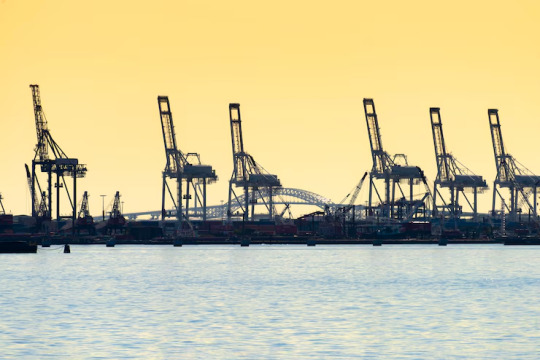
To Get Free Sample Report: https://www.datamintelligence.com/download-sample/small-scale-lng-market
Market Drivers
Clean Energy Transition Liquefied natural gas emits fewer greenhouse gases and air pollutants compared to diesel and heavy fuel oil. Its adoption supports global decarbonization targets, particularly in transport and remote power generation applications.
Marine and Heavy-Duty Transport Growth International Maritime Organization (IMO) regulations limiting sulfur emissions have made LNG a preferred marine fuel. In parallel, rising use of LNG in buses, trucks, and fleet vehicles is accelerating adoption in the transportation sector.
Rise of Modular and Mobile LNG Infrastructure Compact, modular liquefaction units and portable storage tanks are making LNG more accessible in off-grid and underdeveloped regions. These technologies reduce infrastructure costs and deployment time while providing localized energy access.
Remote Industrial & Off-Grid Applications Small-scale LNG is being deployed to meet energy needs in mining, manufacturing, oil & gas operations, and island communities. It enables energy resilience without the need for large-scale pipeline networks.
Government Incentives and Emission Regulations Incentives, subsidies, and regulatory reforms in Asia-Pacific, Europe, and North America are supporting LNG investments. Countries like Indonesia are investing in LNG projects to reduce reliance on diesel in rural power plants.
Regional Insights
Asia-Pacific Asia-Pacific dominates the global market, accounting for over 40% share in 2024. Countries such as China, Japan, and India are leading in LNG import terminal construction, modular LNG facility deployment, and marine LNG bunkering.
North America North America holds a significant share due to its large natural gas reserves, established LNG infrastructure, and rising adoption in transportation. The U.S. is leading new projects targeting fleet fueling and off-grid energy use.
Europe Europe represents nearly 30% of market revenue, led by port-based LNG bunkering, regulatory compliance, and energy transition policies focused on decarbonization and reducing sulfur emissions.
Latin America and Middle East & Africa These regions are emerging players in small-scale LNG, with infrastructure development and pilot projects supporting transportation, remote energy, and industrial processing in off-grid areas.
Market Segmentation
By Terminal Type
Liquefaction Terminals: Account for over 60% of the market, particularly in export-heavy economies and modular on-site LNG production.
Regasification Terminals: Important in off-grid energy supply chains and mobile delivery systems.
By Mode of Supply
Truck-to-Tank (TTT): Dominant delivery method, offering flexibility and mobility across industrial and transportation sectors.
Pipeline & Vessel-Based Supply: Used in larger-volume or coastal operations, especially for bunkering.
By Application
Transportation: Includes marine shipping, trucking, buses, and fleet services.
Power Generation: Remote electrification, emergency backup, and island microgrids.
Industrial Use: Heat and fuel supply for factories, plants, and mining operations.
Utilities: Peak shaving, off-grid storage, and urban distribution.
Challenges
Capital Investment Requirements While modular, small-scale LNG infrastructure still requires significant upfront capital, especially for liquefaction and storage facilities.
Infrastructure & Logistics Gaps Insufficient port, road, and LNG tank infrastructure limit scalability in some regions, especially in Africa and Latin America.
Regulatory Complexity Varying regional safety codes, environmental laws, and certification requirements complicate cross-border LNG adoption.
Renewable Energy Competition In the long term, hydrogen and battery-based technologies may challenge LNG's position in transportation and utility sectors.
Emerging Trends and Opportunities
Bunkering Infrastructure Growth Ports worldwide are expanding their LNG refueling capabilities to meet demand from cargo and passenger ships transitioning from diesel.
Mobile and Scalable LNG Systems Smaller, mobile LNG liquefaction and regasification units are expanding reach in remote mining and island locations.
LNG-Powered Fleets Cities and logistics providers are transitioning to LNG-powered trucks and buses, with dedicated refueling infrastructure.
Green LNG Solutions Development of bio-LNG and synthetic LNG is gaining traction, offering carbon-neutral alternatives to traditional natural gas.
Digital Monitoring and Optimization IoT and AI technologies are being applied to optimize LNG supply chains, track tank levels, forecast demand, and monitor safety.
Subscribe for Insights: https://www.datamintelligence.com/reports-subscription
Leading Market Players
Key companies in the global small-scale LNG market include:
Shell plc
Gazprom
Wärtsilä
Engie
Honeywell International
Linde plc
Chart Industries
Chevron Corporation
TotalEnergies
Chiyoda Corporation
Baker Hughes
Petronas
These players are investing in LNG bunkering, modular systems, and clean transport infrastructure to stay competitive.
Conclusion
The global small-scale LNG market is entering a transformative growth phase, driven by environmental mandates, rising fuel diversification, and technological innovation. As demand for clean, decentralized energy solutions expands across Asia-Pacific, North America, and Europe, small-scale LNG is becoming a critical component in marine transport, heavy-duty vehicles, industrial power, and off-grid energy applications. With its ability to meet both economic and environmental goals, the market is expected to triple in size by 2032, offering substantial opportunities for investment, innovation, and global impact.
0 notes
Text
Half-Yearly Insights: Global LNG Terminal Infrastructure Opportunities | Eninrac Reports
Explore Half-Yearly Insights: Global LNG Terminal Infrastructure. Anticipating 80% growth by 2030, reaching 2700 MTPA. Opportunity analysis and trends.

0 notes
Text
How Crown LNG ($CGBS) Could Quietly Make Early Shareholders Very Loudly Rich
There is something deliciously deceptive about a stock that costs less than a subway swipe yet straddles the same mega-trends driving Exxon, Shell and Berkshire Hathaway to write multi-billion-dollar cheques. Crown LNG Holdings, ticker CGBS, finished the week at $0.11—a price that screams “penny stock” even while the company’s to-do list reads like a Fortune 500 growth plan. The mismatch is so stark that it feels less like a valuation gap and more like a time warp: Wall Street is still pricing yesterday’s risk while Crown is sprinting toward tomorrow’s cash flow.

The macro tailwind nobody can ignore Start with demand. Shell’s 2025 LNG Outlook forecasts about a 60 % surge in global liquefied-gas consumption by 2040, propelled largely by Asia’s industrial boom and the electricity hunger of digital infrastructure. ExxonMobil echoes the theme, saying it is “on track to nearly double its LNG portfolio by 2030,” with projects on four continents already under construction. Berkshire Hathaway, which rarely overpays for hype, bought a 75 % stake in the Cove Point terminal for roughly $3.3 billion—just one facility—because Warren Buffett sees decades of toll-booth cash flows in LNG. If the world’s most disciplined capital allocators are leaning hard into liquefied gas, a developer trading for sixty-odd million dollars begins to look like buried treasure.
The second tailwind is artificial intelligence. The International Energy Agency projects that global data-centre power demand will more than double to about 945 TWh by 2030—roughly Japan’s entire electricity use today—and calls out AI workloads as the prime culprit. Gas-fired turbines remain the only dispatchable source that can ramp fast enough to keep GPUs humming around the clock. A Reuters deep-dive last week made the connection explicit: energy majors are piling into Southeast-Asian gas precisely because data-centre developers have nowhere else to turn for reliable electrons. Crown’s planned terminals sit squarely in that power-hunger corridor.
A four-continent supply web hiding in plain sight. Crown’s blueprint begins with Kakinada, the first gravity-based LNG terminal ever licensed for 365-day operation on India’s cyclone-prone east coast. Its seven-million-tonne capacity would feed power plants and, increasingly, India’s hyper-scale server farms—just as New Delhi pushes gas to 15 % of the national energy mix. Cross half a world to Scotland’s Firth of Forth, where Crown is engineering an import hub aimed at taming Britain’s winter gas price spikes. Slide south-east to Vietnam, an economy whose data-centre footprint is exploding and whose planners forecast multi-million-tonne LNG deficits by 2030. Close the circuit in the U.S. Gulf of Mexico, where Crown’s proposed floating export platform would funnel cheap Permian and Haynesville molecules straight into its own receiving terminals. That is a vertically stitched, four-continent network—a micro-cap doing an impression of an integrated major.
Sceptics will note that Crown has no revenue yet, and they are right. But those same sceptics must grapple with an anomaly: not one core Crown executive has sold a single share in two years. In SPAC land, insiders usually sprint for the exits the day lock-ups expire. Here, they have welded their wallets to the rails. Either they are terrible traders—or they see value invisible to the wider market. For investors who prize alignment, that zero-sale streak is the loudest bullish klaxon in the small-cap universe.
Consider replacement cost. Building just one Kakinada-scale terminal runs to about $1 billion. Crown plans at least two such assets plus an export platform, yet its enterprise value sits around $60 million. Berkshire’s single Cove Point stake, again, cost fifty-plus times Crown’s entire market cap. Even a modest industry rule of thumb—valuing an LNG project at 10-15 % of cap-ex at Final Investment Decision—would catapult Crown’s equity into nine-figure territory the moment financing is nailed down. Eleven cents simply does not compute once steel hits seawater.
Management says it is targeting FID on the Scottish project as early as 2025 and Kakinada by 2026. Each milestone tends to unlock construction debt, long-term offtake contracts, and fresh equity interest. For context, Excelerate Energy’s valuation lifted immediately after its first FSRU charter passed bankable diligence—even before gas flowed—because the market finally trusted the revenue model. Crown is racing toward the same credibility inflection, but from a share price barely scraping double digits.
Wall Street’s crowded trades, mega cap tech, AI chips, large-cap energy, are priced for perfection. Crown LNG is priced as if the future never arrives. Yet Shell, Exxon and Berkshire believe that same future requires vastly more LNG than the world can currently deliver. If even one of Crown’s projects crosses the debt-financing finish line, the stock’s denominator changes faster than most portfolio screens can refresh.
Investors love to say they learn from missed chances. Apple at four, Amazon at eighty, Tesla at twenty. The common thread is that each looked too small, too risky, too early—right until reality rewrote the narrative. Crown LNG sits in that uncomfortable limbo now: tiny quote, giant ambitions, insiders all-in, macro winds at its back. When the first concrete caisson sinks into Indian waters or the first seabed pile is driven in Scotland, today’s eleven-cent tape will feel like ancient history.
History does not repeat, but it certainly rhymes. If you have ever sworn you would never again overlook the bargain hiding beneath an ugly price, Crown LNG is quietly offering you a redo. The only question is whether you will hear the keystone drop before the rest of the market wakes up.
#CrownLNG#LNG#EnergyTransition#AI#DataCenters#NaturalGas#Exxon#Shell#Berkshire#IEA#SPAC#SmallCapStocks#EnergyStocks#GlobalEnergy#AIInfrastructure#IndiaEnergy#UKEnergy#VietnamGrowth#GulfEnergy#StockMarket#InvestSmart#EmergingMarkets#InfrastructureInvesting
1 note
·
View note
Text

Banks significantly increased fossil fuel financing according to the “Banking on Climate Chaos” report published on Tuesday. Fossil Fuel Financing: A Balanced View on the "Dirty Dozen" Banks The Dirty Dozen list points to the 12 banks most heavily involved in fossil fuel financing since the Paris Agreement (2016), sparking criticism from climate groups. But let’s moderate the tone and unpack the complexity:
🪙 What the Numbers Show Yes, these banks — led by JPMorgan Chase, Mizuho, Bank of America, and others — collectively poured hundreds of billions into fossil fuel companies. But:
🌍 Global demand for energy remains high, especially in emerging economies.
🔧 Bank financing often supports infrastructure, not just extraction — like pipelines, ports, LNG terminals.
🔄 Some banks also fund renewables—but those numbers get buried under fossil fuel totals.
🧭 Why They Keep Financing Fossil Fuels Clients need transition time: Oil and gas giants are pledging to shift to low-carbon strategies—but still need cash flow.
Energy security matters: After global shocks price, some nations doubled down on oil & gas for stability.
Financial interests: Fossil fuel projects can offer high returns with long-term contracts—attractive for banks and investors.
⚖️ Room for Critique… and Change While the term “Dirty Dozen” is powerful, it can oversimplify:
❗Many banks have climate pledges, but enforcement is weak or voluntary.
❗“Greenwashing” is a concern—claiming to go green while funding coal or Arctic drilling.
❗Public pressure from youth, investors, and regulators is growing—many banks are slowly adjusting.
🧩
Clear timelines for phase-out of fossil financing.
A massive increase in clean energy investment — where banks can play a constructive role.
0 notes
Text
Zero-Penny Signal: How Crown LNG’s Insider Freeze-Out Could Be the Loudest Buy Alarm on Wall Street
There’s a stubborn myth in small-cap land that insiders always flip their shares the moment lock-ups expire. In SPAC world it’s practically a rite of passage—sponsors cash out, retail bags it. Crown LNG ($CGBS) is shattering that script. Two full years after listing, not one core executive has sold a single share. Zero shares. Zero pennies. In a market drowning in insider distributions, that silence is the loudest statement you’ll hear all year.

Why does it matter? Because insiders are sitting on real risk. Crown isn’t a software outfit with negligible cap-ex; it’s an LNG infrastructure developer aiming to plant billion-dollar terminals in cyclone country and North Sea squalls. The team knows the gantlet ahead—permitting, financing, engineering—and still won’t take chips off the table. That’s Warren-Buffett-level conviction, except Buffett at least collects Coke dividends along the way; Crown’s leadership is paid in unrealised upside.
Contrast that behaviour with the recent wave of energy SPACs. Many sponsors dumped 20–40 percent of their founder shares within months of de-SPACing, a pattern so predictable it became an ETF short thesis. When those same investors glance at CGBS’s insider roster and see no Form 4 sales for eight consecutive quarters, they can’t help but wonder what management sees that the tape doesn’t.
Look at the macro picture they’re front-running. Shell pegs LNG demand to grow roughly sixty percent by 2040, driven by Asian industrialisation and the ravenous power draw of AI data centres. ExxonMobil is ploughing billions into Golden Pass to double its LNG footprint by 2030. ADNOC just approved a five-billion-dollar gas build-out in the UAE. These giants are effectively reposting the same thesis Crown is pursuing—only at global-major scale and valuations a thousand times larger.
Crown’s tiny float compounds the insider story. With virtually all senior leadership stock locked in the vault, each incremental buyer is fighting over a wafer-thin public float. That’s how you get a fifty-five-percent jump to eleven cents on ordinary volume—and why the next off take agreement, engineering contract or FID headline could ignite another gap. We’re still talking about a company worth less than sixty million dollars, yet its Kakinada terminal alone carries a projected cap-ex north of one billion. The mismatch is absurd.
Sceptics will dismiss “no-sale” optics as meaningless without cash flow. Fair—until you remember insiders know the financing conversations the rest of us don’t. They sit across the table from sovereign wealth funds, EPC contractors, and Asian utilities weighing twenty-year regas deals. If the outlook were sour, someone would have taken liquidity. That no one has even trimmed a token block suggests internal confidence in near-term milestones.
Markets aren’t blind to everything; they’re just late to things that don’t file on Bloomberg. When that first concrete pour in Kakinada goes live on social feeds, or when the U.K. government stamps final approval on the Grangemouth terminal, traders will scramble to reverse-engineer why management was welded to its stock certificates. By then, the eleven-cent entry may be folklore.
Crown LNG’s insider freeze-out isn’t just a governance curiosity; it’s a neon sign pointing at asymmetrical value. If you believe LNG demand will keep ripping higher and that scarcity of shovel-ready terminals will command premium economics, the people who know Crown best have already placed their bet—in full view, with full wallets, and with zero exits. The question is whether the rest of the market listens before or after the rerate.
1 note
·
View note